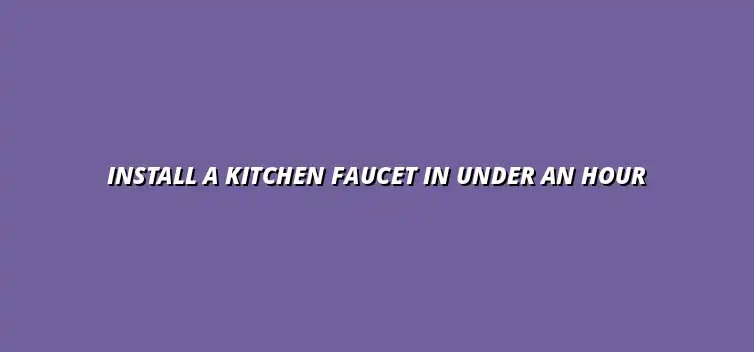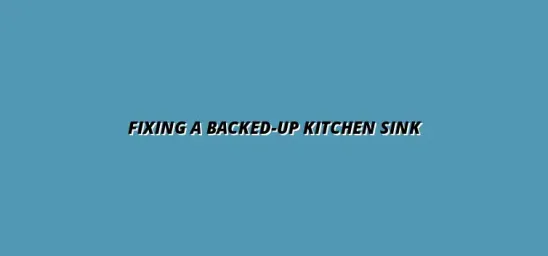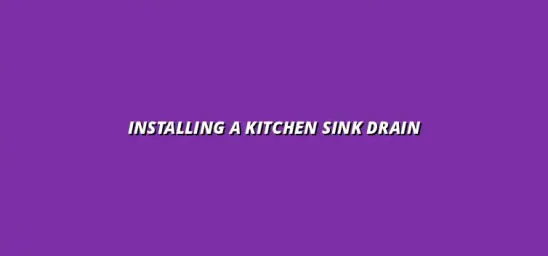
Install a Kitchen Faucet in Under an Hour
Essential Preparations for Installing a New Kitchen Faucet
Before diving into the installation of a new kitchen faucet, it's crucial to prepare properly. This ensures a smooth process and helps avoid unnecessary delays. In this section, I'll guide you through the essential tools and materials you’ll need, how to choose the right faucet, and important safety precautions to consider. If you're feeling overwhelmed, remember that even experienced DIYers sometimes need a helping hand. For those in Birmingham City Centre, consider contacting a local plumber in Birmingham City Centre for assistance.
Understanding the Tools and Materials Needed
Knowing the right tools and materials is a key step in any home improvement project. Getting everything ready beforehand can save you a lot of time and frustration during the installation process. Here's a quick overview of what you’ll need:
Common Tools for Faucet Installation
- Adjustable Wrench: Essential for loosening and tightening fittings.
- Screwdriver: A flathead and Phillips screwdriver will help with various screws.
- Plumber's Tape: This helps prevent leaks by ensuring a tight seal.
- Bucket: Useful for catching any water that might spill during removal.
Materials Required for a New Kitchen Faucet
Besides tools, you'll also need the right materials to ensure everything runs smoothly. Here’s a list of the main materials you should have on hand:
- New Faucet: Choose one that fits your style and needs. Learning how to install your kitchen faucet easily can be a rewarding experience.
- Flexible Water Supply Lines: These connect the faucet to the water supply and can be easier to install.
- Sink Drain Assembly: If your faucet comes with a drain, make sure it's compatible.
- Sealant: This may be needed for a watertight fit.
Choosing the Right Kitchen Faucet for Your Needs
Finding the perfect kitchen faucet means considering both functionality and aesthetics. With so many choices available, it can feel overwhelming. However, understanding the different types and styles can make this decision easier.
Types of Kitchen Faucets and Their Features
- Pull-Down Faucets: These have a spray head that can be pulled down for easy rinsing.
- Pull-Out Faucets: Similar to pull-down, but the head pulls out instead.
- Single Handle Faucets: These allow for easy temperature and flow control with one hand.
- Bridge Faucets: They combine a classic look with separate handles for hot and cold water.
How to Select the Best Faucet Style and Finish
When selecting the style and finish of your faucet, consider how it will match with your kitchen decor. A few points to keep in mind include:
- Finish Options: Chrome, stainless steel, and matte black are popular choices.
- Style: Traditional, contemporary, or industrial styles can set the mood for your kitchen.
- Height and Reach: Ensure the faucet can reach your sink area comfortably.
Safety Precautions Before Starting the Installation
Safety should always be a priority when tackling plumbing projects. Taking a few time-saving safety precautions can prevent accidents and damage to your home. Let’s cover some essential tips!
Important Safety Tips to Follow
- Turn Off the Water Supply: Always shut off the water before you start working.
- Use Protective Gear: Wear gloves and safety goggles to protect yourself from debris and water.
- Work in a Ventilated Area: If you're using any sealants or adhesives, make sure the area is well-ventilated.
How to Handle Plumbing Components Safely
Handling plumbing components can be tricky, so here are a few tips to ensure everything goes smoothly:
- Inspect Components: Before installation, check parts for any defects or damage.
- Be Gentle: Avoid using excessive force when tightening or loosening connections.
- Keep Tools Organized: This prevents accidents and makes the job easier.
Taking these steps will not only prepare you for a successful installation but also set the foundation for a safe and enjoyable DIY project. With the right tools, materials, and preparations, you're on your way to a freshly installed kitchen faucet that looks great and works perfectly! Knowing how to prevent kitchen sink blockages easily is also crucial for long-term functionality.
Addressing Common Questions About Faucet Installation
When you decide to install a new kitchen faucet, questions may arise along the way. It’s perfectly normal to have concerns about potential challenges or how long the entire process might take. Let’s dive into the common questions people often have about faucet installation to help you feel more prepared!
Understanding these queries can ease your mind and make your installation experience smoother. I’ll also provide practical solutions and tips to ensure the process goes as seamlessly as possible.
What If I Encounter Problems During Installation?
Every DIY project can come with its own set of challenges. If you find yourself facing difficulties, don’t worry! Common issues can often be resolved with a little bit of know-how and the right approach. Here are some typical problems you might encounter:
- Leaky connections due to loose fittings.
- Incompatible sizes for water supply lines.
- Rusty or corroded components that are hard to loosen.
For each of these challenges, there’s usually a straightforward solution. For example, tightening fittings can often resolve leaks, and using adapters can help with mismatched sizes. If you have a leaky kitchen sink, remember that prompt attention is key. If you’re still struggling, it might be best to know when to seek professional help.
Common Installation Challenges and Solutions
Here’s a quick rundown of common challenges and effective solutions:
- Leaking: Check if connections are tight and use plumber’s tape if needed. Learning to fix your leaky bathroom faucet can apply to kitchen faucets as well.
- Difficulty removing old parts: Apply penetrating oil and give it some time to work.
- Water supply issues: Ensure you’ve shut off the right valves before starting.
In case the problems persist, don’t hesitate to contact a professional plumber. They have the experience to tackle more complex issues that might arise. Even seemingly minor issues like a blocked sink can escalate; learn to unclog your sink with a plunger to avoid bigger problems.
How Long Should Faucet Installation Typically Take?
The time it takes to install a new kitchen faucet can vary based on several factors. If you’re well-prepared and follow a clear process, you might complete the job in just a couple of hours. However, unexpected hurdles can extend the timeline. Dealing with a leaking pipe elsewhere in your home can also add complications; see our guide on repairing a leaking water heater pipe for similar troubleshooting.
Let’s take a look at some factors that can influence how long the installation will take:
- Experience level with plumbing tasks.
- Condition of existing plumbing and fittings.
- Complexity of the new faucet design.
Factors That Can Affect Installation Time
It's important to be aware of how these elements can impact your project:
- Preparation: Gathering tools and materials ahead of time can save you valuable minutes.
- Existing Setup: If your old faucet is stubborn and won’t come off easily, this can add extra time.
- Help: Having a friend assist can speed up the process.
By considering these factors, you can better estimate how long your project may take. Remember, it’s always a good idea to set aside a bit more time than you think you need!
Final Thoughts on Installing a Kitchen Faucet
Installing a kitchen faucet is a rewarding project that can enhance your home. With the right preparation and knowledge, you can tackle this task confidently. If something goes wrong, just remember that you’re not alone—many people face similar challenges!
Taking care of your faucet after installation can help ensure it lasts for years to come. Regular checks can prevent bigger issues down the road, keeping your kitchen running smoothly.





Fixing a Backed-Up Kitchen Sink
Prepare Your Plumbing for Weather
Installing a Kitchen Sink Drain
When to Replace Plumbing Fixtures
Fixing a Jammed Garbage Disposal